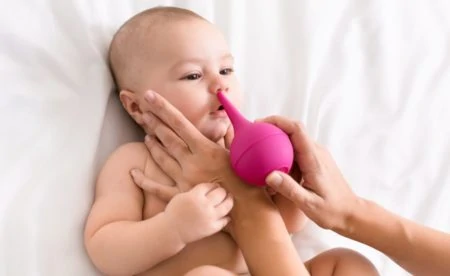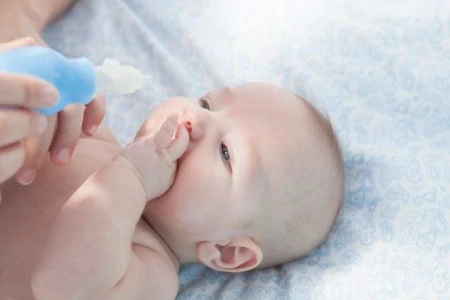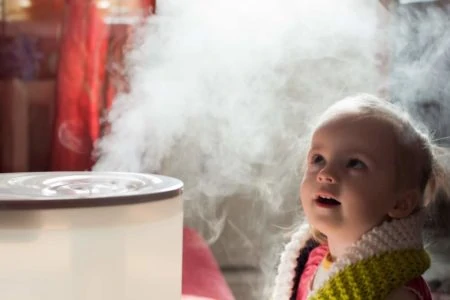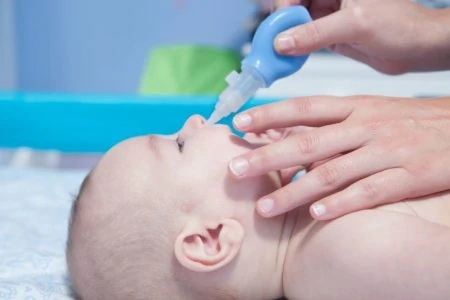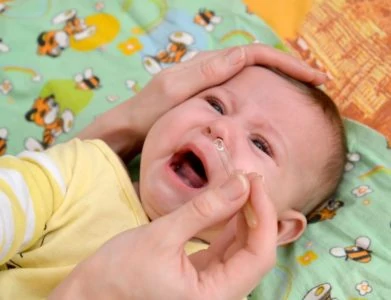Hearing your baby struggle to breathe is stressful for any parent. Because babies have tiny nasal passages, it doesn’t take much mucus to cause a blockage. And since newborns primarily breathe through their noses, a stuffy nose can make eating and sleeping difficult.
If your little one is snorting, fussy, or struggling to feed, congestion is likely the culprit. While you can’t blow their nose for them, you can help clear the way.
We have compiled the safest, most effective methods for relieving baby congestion. From saline drops to the best suction tools, here is how to help your baby breathe easier today.
Key Takeaways
- Common Causes: Small nasal passages, dry air, viral colds, and irritants like dust or smoke often cause congestion.
- Best Tools: Use saline drops or spray to loosen mucus, then follow up with a bulb syringe, electric aspirator, or mouth-suction aspirator.
- Safety First: Limit suctioning to 3 or 4 times a day to prevent inflammation or nosebleeds.
- When to Call: See a doctor if your baby struggles to breathe, has a fever, stops feeding, or if symptoms last longer than a week.
Why Is My Baby Congested?
It is heartbreaking to see your newborn uncomfortable. A baby with a stuffed nose often refuses to eat, which naturally worries parents.
However, congestion isn’t always a sign of sickness. Here are five common reasons your baby might sound stuffy:
- Tiny Anatomy: Your newborn’s nasal passages are incredibly small. Even a tiny amount of mucus or swelling can cause loud breathing or snorting. If they are eating and sleeping well, they might just be “noisy” rather than sick.
- Obligate Nose Breathers: Babies instinctively breathe through their noses to allow them to feed and breathe simultaneously. Since they don’t know how to switch to mouth breathing yet, a blocked nose makes them panicked and cranky.
- Inability to Blow: Unlike adults or older kids, babies cannot blow their noses. Mucus, dust, and spit-up can accumulate and dry out, creating blockages that require your help to remove.
- Environmental Irritants: Dry air, cigarette smoke, pet dander, perfumes, and dust can inflame delicate nasal tissues. Ensuring your baby is breathing clean air helps reduce this inflammation (1).
- Viruses and Illness: If the stuffiness comes with a runny nose, fever, or cough, it could be a cold virus, influenza, or RSV. Respiratory Syncytial Virus (RSV) causes significant mucus production and can lead to bronchiolitis (2).
How to Clean Your Baby’s Nose
Since your baby cannot blow their nose, you need to clear the gunk for them. The “gold standard” method usually involves two steps: loosening the mucus with saline and then removing it with suction.
1. Saline Drops or Spray
Saline is essentially salt water. It is safe, gentle, and crucial for breaking down thick, sticky mucus. Saline nasal sprays or drops moisten the nasal passages and thin the secretions so they can drain naturally or be sucked out easily (3).
How to use it:
- Lay your baby on their back.
- Gently tilt their chin up slightly (you can place a rolled towel under their shoulders if it helps).
- Squeeze one or two drops into each nostril.
- Wait 30 to 60 seconds. This dwell time is important to let the saline work its magic.
Sometimes, saline alone is enough to trigger a sneeze that clears the blockage. If not, move on to suction.
2. Bulb Syringe
You likely received a rubber bulb syringe at the hospital or in a baby grooming kit. While basic, they are effective for quick cleanups.
How to use it:
- Squeeze the air out of the bulb before putting it near your baby’s nose.
- Gently insert the tip into the nostril. Do not go too deep; you only need to create a seal at the opening.
- Slowly release your grip on the bulb to create suction.
- Remove the syringe and squeeze the mucus onto a tissue.
Clean the bulb with hot, soapy water immediately after use. Mold grows easily inside these bulbs, so ensure it dries completely.
3. Nasal Aspirator (The “Snot Sucker”)
A nasal aspirator (like the NoseFrida) uses your own lung power to clear congestion. It sounds gross, but don’t worry; there is a filter to prevent anything from reaching your mouth. Many parents find this gives them more control than a bulb syringe.
How to use it:
- Place the mouthpiece in your mouth and the tube tip against your baby’s nostril (not inside it).
- Create a seal with the tip.
- Gently suck in. You can control the strength of the suction.
- Rotate the tube gently in a circular motion to catch stubborn mucus.
Always clean the tube and replace the filter regularly according to the manufacturer’s instructions.
4. Electric Nasal Aspirator
If the idea of mouth-suction makes you queasy, an electric aspirator is a great alternative. These battery-operated devices provide a steady, continuous suction that is safe for infants. They often come with silicone tips of various sizes to fit tiny nostrils.
Simply push the button and gently gently move the tip around the nostril opening. Some models even play music or light up to distract your fussy baby.
5. Safety: How Often Should You Suction?
More isn’t always better. You should only use suction 3 to 4 times in a 24-hour period.
Suctioning too frequently irritates the delicate tissues inside the nose, causing swelling that makes congestion feel even worse. It can also lead to nosebleeds.
The best times to clean the nose are:
- Before feeds: A clear nose allows the baby to suck and breathe simultaneously.
- Before bed: This helps everyone get a longer stretch of sleep.
6. Tips for Success
- Stay Calm: Your baby feeds off your energy. Talk in a soothing voice.
- Get Help: If your baby is squirmy, have a partner gently hold their hands while you manage the nose.
- Wash Up: Always wash your hands before and after to prevent spreading germs to yourself or siblings.
How to Prevent Baby Congestion
Prevention is often about managing your environment. Since you can’t suction all day long, use these methods to keep mucus loose and flowing naturally.
- Use a Cool Mist Humidifier: Heating systems and air conditioners dry out the air, which thickens mucus. Running a humidifier in the nursery adds moisture back into the air, soothing the nasal passages (4). Stick to cool mist models to avoid burn risks.
- The “Steam Room” Trick: If you don’t have a humidifier, turn on a hot shower and sit in the steamy bathroom with your baby for 10 to 15 minutes. The warm humidity works wonders to loosen sticky congestion before you try suctioning.
- Keep Them Hydrated: Proper hydration thins mucus. If you are breastfeeding, offer the breast frequently. Formula-fed babies should continue to eat on demand. Monitor wet diapers to ensure they are getting enough fluids.
- Keep Baby Upright: During awake time, keep your baby upright in a carrier or hold them against your shoulder. Gravity helps drain the sinuses naturally. (Note: Always place baby on their back on a flat, firm surface for sleep).
Remedies to Avoid
Not all adult remedies are safe for infants. Avoid these common mistakes:
- No Cotton Swabs (Q-Tips): Never put a cotton swab inside your baby’s nose. It pushes mucus further back and risks damaging the sensitive lining or perforating the nasal area if the baby jerks their head.
- Avoid Strong Vapor Rubs: Products containing camphor or high concentrations of menthol are unsafe for children under 2. They can actually increase mucus production and irritate sensitive skin. Stick to chest rubs specifically labeled for babies (usually 3 months+).
- Skip the Neti Pot: While great for adults, Neti pots flood the nasal cavity with water, which increases the risk of choking or drowning in infants. Stick to drops or sprays.
- Essential Oils: Many essential oils are not safe for babies. Always consult your pediatrician before diffusing oils or applying anything to your baby’s skin.
Decongestants and cold medicines are used by older children and adults occasionally to alleviate nasal congestion. These medications have demonstrated very little benefit for babies and have not been well-studied in infants and young children. The FDA recommends using caution due to potential overdose and toxic effects (5). The American Academy of Pediatrics has taken this a few steps further and, because of reports of harm outweighing the little benefit, recommends that they should not be used until after the age of 6 (6).
Editor's Note:
Dr. Gina Jansheski, MD, FAAPWhen to Call the Doctor
Congestion is common, but it can escalate. Call your pediatrician if:
- Symptoms last longer than a week or are getting worse.
- You suspect an allergy or a foreign object is stuck in the nose.
- Your baby is under 3 months old and has a fever (100.4°F or higher).
Seek immediate medical attention if your baby shows signs of respiratory distress:
- Retractions: The skin sucks in between the ribs or at the neck when breathing.
- Flaring: The nostrils widen with every breath.
- Color Change: Lips or skin turn blue or gray.
- Rapid Breathing: More than 60 breaths per minute.
- Dehydration: Fewer than 4 wet diapers in 24 hours.
